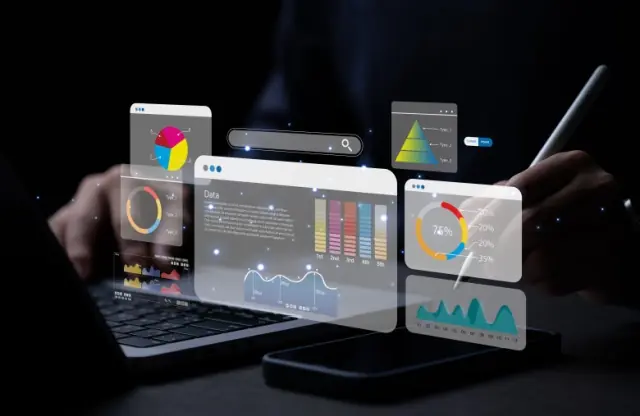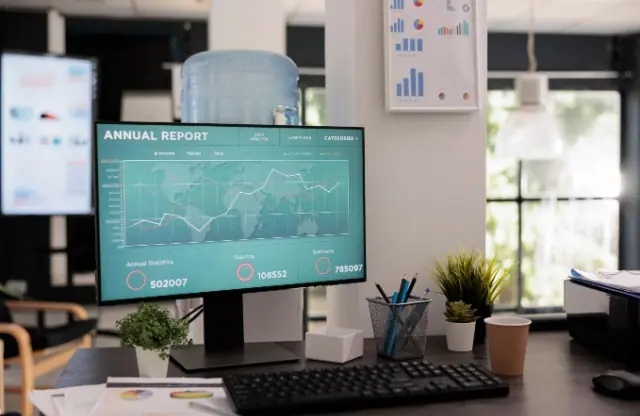Enhancing Communication through Annual Report Design
 Share
Share
 Copy Url
Copy Url

Designing an annual report can be a fun and creative task for any graphic designer. When working on an annual report design, it's important to consider the latest trends. A well-crafted annual report is more than a summary of the year's activities; it's a visual journey. With the right graphic designer for an annual report, you can transform mundane data into an engaging story. One key aspect is the annual report cover page design, which sets the tone for the entire document. Modern annual reports often feature sleek layouts and vibrant colors that catch the eye.
In this article, we'll delve into various aspects of annual report design. We'll discuss what to include in your annual report, the benefits of creating one, and learn who benefits from it. You'll also learn about the time required to design an annual report and the advantages of a well-crafted design. Additionally, we'll share tips on how to create impressive annual reports. Whether you're aiming to impress stakeholders or want to stay updated with the latest annual report design trends, we've got you covered. Stay tuned as we explore these topics in detail.

What is an Annual Report?
An annual report is a detailed document covering a company's activities and financial performance for the past year. It gives shareholders and investors a clear view of the company's operations and financial health. This report often includes a variety of sections. These include a letter from the CEO, performance highlights, financial statements, and a look ahead at future goals and strategies.
Annual report design plays a crucial role in making the document engaging and informative. Incorporating effective graphic design can turn dense financial data into compelling visuals, making the information more accessible. The annual report cover page is particularly important as it sets the tone for the entire report. A modern, eye-catching cover can capture the reader's interest right from the start.
Inside, a well-organized table of contents helps readers navigate the document easily. Each section is designed to communicate specific information. For example, The CEO’s letter usually discusses the company's achievements and plans. Financial statements provide a quantitative look at performance. Other sections may highlight key milestones and strategic initiatives.
For any company or organization, keeping up with the latest annual report design trends ensures the report remains modern and relevant. This includes using contemporary layouts, vibrant colors, and interactive elements in digital versions.

Essential Inclusions in an Annual Report
An annual report has certain essential inclusions to ensure it communicates the necessary information effectively and adheres to standard practices. Let's explore the key components that you should include in your annual report design.
Message from the CEO/Chairman
This section introduces the annual report and includes a brief message from the CEO or chairman. It covers major developments, company initiatives, and a snapshot of the financial status. This part sets the tone and context for the report, providing important information about the company's achievements and challenges over the year.
Table of Contents
The table of contents is crucial in an annual report as it helps readers navigate the document easily. Given the report's length, a clear table of contents directs readers to specific sections and important information efficiently. This enhances user experience, especially when looking for particular data or sections.
Company Profile
This section outlines the company’s mission, vision, and strategic objectives. It often includes details about the board of directors, key officers, corporate addresses, and an overview of the company’s products and services. It provides a foundational understanding of what the company does and its market position.
Business Performance Analysis
This analysis covers the company's performance, highlighting profit margins, sales, and income. It discusses significant events, new product launches, and changes in performance due to new strategies. This section offers a narrative of the company's operational success and strategic initiatives over the past year.
Financial Statements
Financial statements are a critical part of the annual report. They include the balance sheet, income statement, and cash flow statement. These documents provide a quantitative look at the company's financial health, showing revenue, expenses, and financial position. This section is important for investors and stakeholders. Especially since it helps them understand the company's financial performance.
Corporate Governance
The corporate governance section explains how the company’s operations align with its objectives. It includes reports on the board's activities, committee reports, and compliance with governance standards. This section ensures transparency and accountability, crucial for building stakeholder trust.
Future Plans
This section offers stakeholders a peek into the organization's strategic roadmap. It includes forthcoming goals, initiatives, and expected challenges, painting a picture of the organization's strategic intent. This could encompass expansion plans, product innovation, talent development, sustainability efforts, and more. It demonstrates the organization's forward-thinking nature, reassuring stakeholders about its readiness to seize future opportunities and tackle challenges.
Disclosures and More Information
This part includes any other important disclosures, such as changes in accounting policies, auditor comments, and disclaimers about predicted income and expenses. It may also feature stories, infographics, and photographs to make the report more engaging. This section ensures all necessary information is covered comprehensively.
Incorporating these elements in your annual report design does several things. It ensures compliance with standard practices and enhances clarity and engagement for readers. When you create your report, consider working with graphic designers for annual reports to use effective data visualization and modern design trends. This approach helps present the financial report in a more appealing and accessible manner.

10 Key Benefits of Creating Annual Reports
1. Transparency
An annual report provides a transparent view of an organization's operations, performance, and financial status. This openness helps foster trust and credibility among stakeholders, including investors, employees, and the public.
2. Brand Awareness
Annual reports present an opportunity to reinforce and enhance your organization's brand image. A professionally designed report can help cement your company's identity in the minds of readers, leaving a lasting impression.
3. Engagement
A well-designed annual report can captivate its audience. It turns raw data into a compelling narrative, making the information accessible and engaging for readers, increasing their likelihood to interact with the content.
4. Storytelling
Annual reports are an excellent platform for storytelling. They can chronicle your organization's journey over the past year, highlighting key accomplishments and challenges, and creating a narrative that connects emotionally with your audience.
5. Investor Relations
Annual reports are crucial in attracting and retaining investors. They present a detailed view of the organization's financial health and future prospects, aiding potential investors in decision-making and helping maintain strong relationships with existing investors.
6. Regulatory Compliance
Annual reports help organizations achieve regulatory compliance by meeting mandated requirements. Many jurisdictions require companies to publish these reports, ensuring they comply with laws and regulations. This practice helps organizations avoid potential penalties and maintain transparency in their operations.
7. Marketing Tool
A well-crafted annual report can act as a potent marketing tool. Highlighting successful projects, initiatives, and achievements can attract potential clients or customers and drive business growth.
8. Employee Engagement
Annual reports can boost employee morale and engagement by showcasing their contributions to the organization's success. It creates a sense of shared achievement and promotes a unified corporate culture.
9. Strategic Planning
Annual reports provide a clear view of past performance, helping organizations in strategic planning. Insights gleaned from the report can inform future decisions, guiding the direction of the company.
10. Accountability
Annual reports establish a level of accountability for an organization. They ensure that the company is responsible for its actions and decisions over the past year, reinforcing its commitment to ethical business practices and corporate responsibility.

Who Uses and Benefits from Annual Reports?
Annual reports are essential documents available to the public, targeting a wide external audience such as shareholders, potential investors, employees, and customers. They also attract interest from the general community, as companies and non-profits might review another company’s annual report to assess potential partnerships or collaborations.
While primarily used for sharing financial and performance data, annual reports also serve as advertising tools to highlight recent achievements and key initiatives. Effective annual report design can make these highlights more engaging.
Shareholders and Potential Investors
Shareholders and potential investors rely on annual reports to understand the company’s current status and make informed investment decisions. The report provides insights into plans, goals, and objectives, helping potential investors decide whether to buy stock.
Employees
Employees use annual reports to grasp the company’s various focus areas. Many employees are also shareholders due to stock option benefits and other incentives, making the report valuable for understanding their investments.
Customers
Customers review annual reports to compare different companies and decide which one to engage with. They seek high-quality suppliers of products or services, and the report helps emphasize a company’s core values and objectives. Additionally, financial information in the report offers customers a clear picture of the company's financial health.
Annual report designers play a crucial role in creating a unique annual report design that effectively visualises data and attracts the interest of diverse audiences. Every annual report, with the help of graphic design elements, can turn simple data into compelling stories that resonate with readers.

How Long does it take to Design an Annual Report?
Designing an annual report is a detailed and time-consuming process that can vary significantly based on several factors. Typically, the process can take anywhere from one to six months, depending on the complexity and scope of the project.
The timeline for an annual report design starts with gathering all necessary content. This includes financial statements, performance analysis, and any other essential sections. Once the content is ready, it usually takes about 4-6 weeks to design and produce the report. This also depends on whether the scope is standard and straightforward. For more complex reports, especially those requiring intricate graphic design or extensive data visualization, the process can extend up to six months.
Several factors influence the time required to design an annual report. The complexity of the content is a significant factor. Reports with extensive data, requiring detailed charts and graphs, take longer to design. The experience level of the annual report designers also plays a crucial role. More experienced designers may complete the task more efficiently, but they also might take more time to ensure high-quality work.
Another key factor is the approval process. Some companies need many rounds of revisions and approvals from various stakeholders, which can add to the timeline. Additionally, elements like the cover design and the theme can impact the duration. A creative and engaging cover design might need extra iterations and adjustments to align with the company’s brand identity.

Advantages of Great Annual Report Design
A great annual report design offers many benefits from a design perspective. This makes the document informative, engaging, and visually appealing. Here are some key benefits:
1. Enhanced Visual Appeal
A well-designed annual report transforms plain data into an engaging visual story. Annual report designers use graphic design techniques to create visuals that capture attention and make the report enjoyable. They use a mix of images, colors, and layouts to present a company's achievements and important information effectively.
2. Improved Data Comprehension
Great annual report design uses infographics, charts, and graphs to present complex data simply. These elements make dense information accessible and memorable. Visual tools highlight key metrics and achievements clearly.
3. Brand Reinforcement
An annual report is an excellent opportunity to reinforce a company’s brand identity. Through consistent use of brand colors, fonts, and imagery, the report can reflect the company’s values and mission. This cohesive design approach helps in building brand recognition and trust among stakeholders.
4. Increased Engagement
Incorporating interactive elements and dynamic visuals in an annual report design boosts reader engagement. Features like interactive charts, clickable infographics, and multimedia elements keep readers engaged and make the report interesting to explore. This approach can turn a traditionally dry document into a compelling digital experience.
5. Effective Communication
A neat design ensures that the most important information stands out and is easy to find. Clear headings, a structured layout, and visual highlights guide readers through the content effortlessly. This improves readability and ensures key messages are effectively communicated.
In summary, a well-designed annual report conveys financial and operational information in a visually appealing, engaging, and brand-reflective way. This makes it a powerful tool for communication and marketing.

Types of Annual Reports
Annual reports can take various forms, depending on the organization's needs and audience. Here are the most common types:
Traditional Annual Reports
Traditional Annual Reports are extensive, detail-oriented documents that are primarily used by publicly traded companies. They provide a full account of the company's financial status, including income statements, balance sheets, and cash flow statements. These reports also include in-depth commentary on the company's performance, market trends, risks, and outlook. They are crucial in maintaining transparency and accountability towards shareholders and regulators.
Summary Annual Reports
A Summary Annual Report is a condensed version of the traditional report. It prioritizes brevity and focuses on the key highlights and major achievements of the year. Although it provides less detail, it effectively communicates the company's progress, performance, and future direction. These reports are especially valuable for stakeholders who want an overview without having to delve into extensive financial data and analysis.
Interactive Annual Reports
Interactive Annual Reports are an evolution of the traditional format, adapted for the digital age. They are online reports enriched with interactive design elements like videos, infographics, and clickable sections. The interactivity allows readers to engage with the content more dynamically, tailoring the experience to their interests. These reports can provide an immersive experience, making the content more accessible and enjoyable for the audience.

Important Annual Report Design Tips to Use
Creating an effective annual report design involves several key strategies that ensure your report is engaging, informative, and visually appealing. Here are some tips to help you achieve a standout report:
1. Engage with a Strong Cover Design
First impressions matter. An eye-catching cover design can draw readers in and set the tone for the entire report. Use photography and graphic design elements to establish the theme, typography, and color palette that will carry through the report. A creative cover can make your report stand out.
2. Use Infographics and Charts
Presenting complex data through infographics and charts makes the information easier to digest. Visuals like these help break down simple data into more engaging formats, highlighting key metrics and achievements. This approach not only simplifies data but also makes it memorable.
3. Maintain Consistency with Branding
Incorporate your company’s branding consistently throughout the report. This includes using brand colors, fonts, and logos to reinforce your brand identity. Consistent branding helps in creating a cohesive and professional-looking annual report.
4. Leverage Bold Colors and Typography
Using bold colors and varying font sizes and weights can draw attention to important information. This technique ensures that key messages stand out and enhances the visual appeal of the report. Yet, balance is crucial to avoid making the design too busy.
5. Optimize for Digital Viewing
With more people viewing reports online, optimizing your annual report for digital platforms is essential. Incorporate interactive elements like clickable charts, videos, and animations to enhance engagement. Digital reports can reach a wider audience and offer a more dynamic user experience.
6. Use White Space Effectively
White space, or negative space, improves readability by preventing the page from feeling cluttered. It helps highlight the most important points and guides the reader’s eye through the content. A neat design with adequate white space makes the report easier to read and more visually appealing.
7. Include Meaningful Visuals
Photos and other visuals should add value to the content. Use images that support the text and contribute to the overall narrative. For instance, grayscale images can seamlessly blend into the design without distracting from the information.
8. Set a Visual Tone Throughout
Establish a visual tone from the cover to the last page. This could be through the consistent use of specific colors, fonts, and design motifs that reflect the company’s identity and the report’s theme. A cohesive visual tone keeps the reader engaged and ensures the report is visually appealing.
9. Reflect Company History
Let your company’s history influence the design. Using historical elements can provide context and add depth to your report. This approach can also help in creating a unique annual report design that resonates with long-time stakeholders and new readers alike.
By incorporating these tips, you can create an annual report design that not only communicates your company’s achievements effectively but also engages and impresses your audience.

Get Unique Annual Report Design with Report Yak
A well-designed annual report boosts your organization's communication and engagement with stakeholders. Effective annual report design turns boring financial data into an interesting visual story. This grabs readers' attention and clearly conveys key messages. Using the latest design trends, annual report designers create reports that are both visually appealing and informative, showcasing a company's achievements and goals.
To make your annual report stand out, partner with Report Yak, the best annual report design agency in India. Our experienced team of content writers and graphic designers stays updated on design trends and corporate reporting standards. We specialize in annual report design, ESG reports, sustainability reports, integrated reports, impact reports, and other important financial documents.
Visit our Showcase page to see examples of our work, or learn more about our services on our Services page. Call us at 1800 121 5955 (India) or email us at contact@reportyak.com with your requirements. Alternatively, fill out the Contact form on our website or send us a WhatsApp message to schedule a call. Let Report Yak help you create a unique annual report design that effectively visualises your company’s achievements and engages your audience.
Related Posts
-
Simplifying ESG Disclosure for Better Impact
corporate reportingenvironmental and social initiatives
+6
Aug 28, 2025Share
Copy Url
GRI Sustainability Taxonomy: Learn How to Turn Data Into Advantage
corporate governancecorporate reporting
+11
Jul 1, 2025Share
Copy Url
See How Components of an Annual Report Drive Business Confidence
annual reportAnnual Report design
+7
Jun 24, 2025Share
Copy Url


